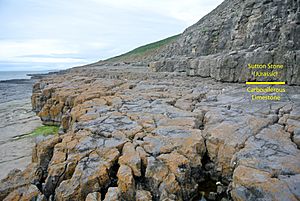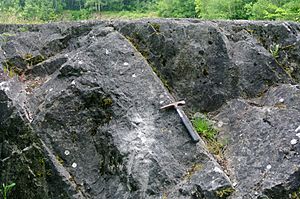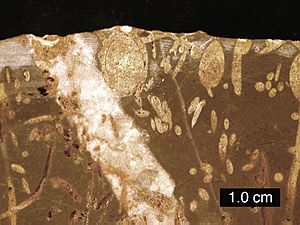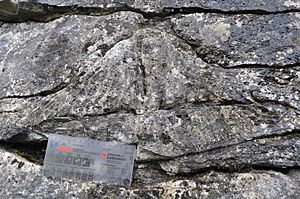Carboniferous Limestone facts for kids

Carboniferous Limestone is a type of limestone rock found across Great Britain and Ireland. It formed a long, long time ago, between 363 and 325 million years ago, during a period called the Carboniferous Period. These rocks were made from the shells and hard parts of countless sea creatures that lived in warm, shallow tropical seas.
In England and Wales, all these limestone layers, along with some mudstones and thin sandstones, are known as the Carboniferous Limestone Supergroup.
Contents
Where Carboniferous Limestone is Found

Carboniferous Limestone was formed in different areas, or "provinces," across Great Britain. These areas were separated by ancient landmasses. One important landmass was the Wales-London-Brabant Massif, which stretched through central Wales and the English Midlands into Belgium.
- South of the Massif: Limestones formed in a region from Pembrokeshire in Wales, through Glamorgan, Gloucestershire, and north Somerset in England.
- North of the Massif: Another area of limestone formed north of this landmass, extending up towards the Southern Uplands in Scotland. This area had many different "blocks" and "basins," meaning the rock formed in slightly different ways in each spot.
- Scotland: In Scotland, limestones are found in the Scottish Lowlands, from Ayrshire to Fife. Even though they are from the Carboniferous Period, they are not part of the Carboniferous Limestone Supergroup.
- Ireland: Carboniferous Limestone is also very common throughout Ireland.
What Does Carboniferous Limestone Look Like?

Carboniferous Limestone is a hard rock, mostly made of calcium carbonate. It's usually light grey. It was formed in warm, shallow tropical seas that were full of life. The rock is packed with fossils of ancient sea creatures like corals, brachiopods (shellfish), and crinoids (sea lilies).
This limestone has horizontal layers called "beds" and vertical cracks called "joints." These joints are weak spots where water can get in. This leads to a special feature of Carboniferous Limestone: it's very permeable, meaning water can easily seep through it.
Over millions of years, massive Earth movements have pushed these rocks up above sea level, so they are no longer flat at the bottom of the sea.
Amazing Features of Limestone Landscapes
When water seeps through the joints in limestone, it creates a unique landscape called karst. Karst landscapes often don't have rivers or streams on the surface, because the water goes underground.
Surface Features

- Sinkholes: These are funnel-shaped hollows on the surface, common in places like the Yorkshire Dales and Brecon Beacons. They form when the ground above an underground cave collapses, or when surface material slowly drops into caves.
- Swallowholes (Potholes): Streams flowing from higher ground often disappear into the earth when they reach permeable limestone. These large holes where water vanishes are called swallowholes or potholes. Famous examples include Gaping Gill.
- Dry Valleys: These are valleys that don't have any streams flowing through them. A great example is Watlowes Valley in the Yorkshire Dales. It was formed by meltwater from glaciers during the last Ice Age. After the ice melted, the water started flowing underground through the limestone, leaving the valley dry.
- Limestone Pavements: These are areas of flat, almost bare rock. They form when glaciers scrape away the soil, exposing the limestone. Rainwater then seeps into the existing joints, making them deeper and wider. These deep cracks are called "grykes," and the rounded blocks of rock are called "clints."
- Malham Cove: This is a huge, dry cliff (83 meters high) in the Yorkshire Dales. During the Ice Age, a stream flowed over it. But after the ice melted, the water started to disappear underground through the limestone's joints, leaving the cliff dry.
- Gorges: A gorge is a steep-sided valley. They often form in limestone areas when the roof of an underground cave system collapses. Gordale Scar is a famous example.
Underground Features: Caves!
Caves are very common underground features in limestone areas. In the Yorkshire Dales, you can visit show caves like Ingleborough Cave and White Scar Caves. Ireland also has many show caves, such as Crag Cave and Aillwee Cave.
- Stalactites and Stalagmites: These amazing formations are found inside caves. Rainwater, which is a weak acid, seeps through the limestone, dissolving it. As this lime-rich water drips from the cave roof, some of it evaporates, leaving behind tiny bits of limestone. Over thousands of years, a stalactite grows down from the ceiling. When the water drips onto the floor, a stalagmite grows up from the ground. If they grow long enough, they can meet and form a stone pillar!
Uses of Carboniferous Limestone
Carboniferous Limestone is a very useful rock, even though it's too brittle for many building purposes. It is widely quarried for other uses:
- Roads and Construction: It's crushed and used as roadstone and aggregate (small stones mixed with cement) for building roads and other structures.
- Lime Production: It's burned to make lime, which is used in many industries, including agriculture and construction.
- Cement: It's a key ingredient in making cement.
- Pollution Control: Ground-up limestone is used to clean gases from power plants, helping to reduce air pollution.
- Metals: In some places, Carboniferous Limestone contains valuable metals like lead and copper. Ancient mines in North Wales show that copper was mined here even in the Bronze Age.
- Iron Industry: During the early Industrial Revolution, limestone was important for making iron when combined with nearby coal and ironstone.
|


